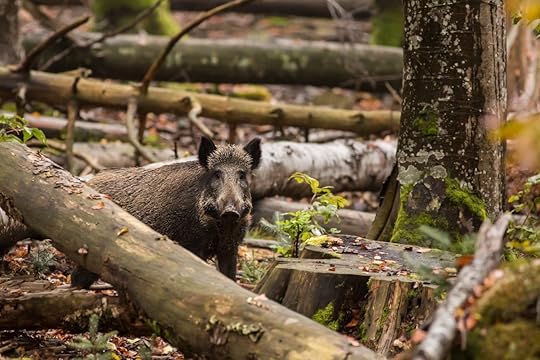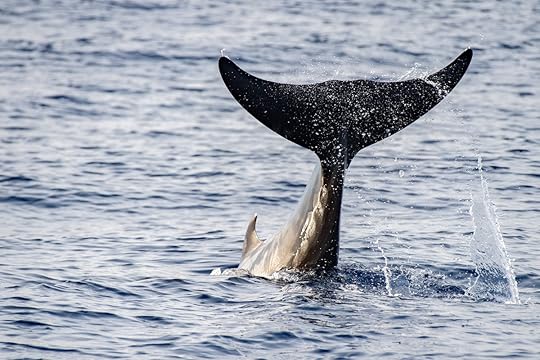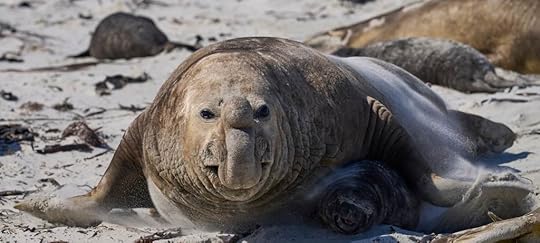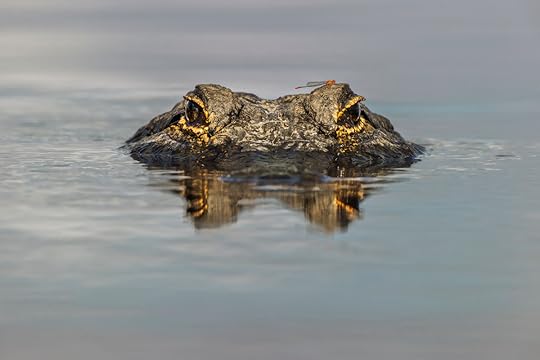Ripley Entertainment Inc.'s Blog, page 7
September 18, 2023
CARTOON 09-18-2023
September 17, 2023
CARTOON 09-17-2023
September 16, 2023
CARTOON 09-16-2023
September 15, 2023
Truffles from Nuclear Fallout Are Making German Wild Boars Radioactive
Featured in Ripley's Believe It or Not!

Scientists have finally determined why wild boars in Germany are still showing signs of radioactivity, and it has to do with their diet in addition to the aftereffects of nuclear weapon testing and the Chernobyl disaster. History’s worst man-made disaster occurred in 1986, yet the level of radioactivity found in these wild boars hasn’t gone down — something experts are now attributing to truffles.
Bavarian BoarsA large area of Europe, including Bavaria in Southwestern Germany, was affected by nuclear fallout after the Ukrainian power plant exploded nearly 40 years ago. Elements from the reactor, such as cesium-137, can survive for decades. And it does not hit its half-life for approximately 30 years. That may seem like a long time, but it’s not if you compare it to cesium-135, which has a half-life of 2.3 million years!
Chernobyl-related contaminants in a variety of species have dropped in Bavarian forests over the past six decades. Scientists however, have not seen a decrease in radioactive levels in boars. Since cesium-137 has a half-life of 30, there was some confusion as to why these boars continue to show such high levels of contamination. There is even a term for this phenomenon: the wild boar paradox.
To determine the reason for this paradox, scientists examined the bodies of 48 boars in 11 Bavarian districts from 2019 and 2021. A study published in the journal Environmental Science and Technology concludes that nuclear weapons testing during the Cold War and radioactivity from Chernobyl led to a buildup of contaminants in fungi, including deer truffles, that the boar like to eat.
Toxic TrufflesTo figure out the specific source of the radioactivity, scientists examined the ratio of cesium-135 to cesium-137. A high ratio of cesium-135 to cesium-137 signals that nuclear weapon explosions are the source; whereas a low ratio points to nuclear reactors.
Researchers used soil samples from Chernobyl and Fukushima in addition to human lung tissue from 1960s Austria. They compared them to the isotopic fingerprint of the boar meat. The lung tissue showed signs of contaminants from Cold War nuclear weapons testing. The weapons were not detonated at the study site, indicating that fallout from the nuclear tests traveled in the atmosphere.

The destroyed Chernobyl reactor, one of four units operating at the site in Ukraine in 1986. Credit: IAEA Imagebank Via Wikimedia Commons (CC BY-SA 2.0).
Eighty-eight-percent of the samples surpassed the acceptable limit for radioactive cesium in Germany. Nuclear weapons testing was responsible for 10–68 percent of the contamination. Scientists concluded that underground truffles absorbed the toxins from both the weapons testing and the Chernobyl incident.
According to researchers, “This study illustrates that strategic decisions to conduct atmospheric nuclear tests 60–80 years ago still impact remote natural environments, wildlife, and a human food source today.”
Want More?Are you curious about what is still standing nearly 40 years after the Chernobyl nuclear power plant disaster? In addition to structures related to the reactor itself, there’s actually a nearby amusement park that is still partially intact! Check out the video below to learn more.
There is something morbidly fascinating about nuclear weapons and disasters. That’s why Ripley’s Believe It or Not! recently added to it’s own collection a piece of nuclear history: a graphite disc from Chicago Pile-1 — the world’s first artificial nuclear reactor!
Every Ripley’s Believe It or Not! is filled with historical artifacts — visit a location near you and see what you can uncover!
By Noelle Talmon, contributor for Ripleys.com
EXPLORE THE ODD IN PERSON! Discover hundreds of strange and unusual artifacts and get hands-on with unbelievable interactives when you visit a Ripley’s Odditorium!Source: Truffles from Nuclear Fallout Are Making German Wild Boars Radioactive
CARTOON 09-15-2023
September 14, 2023
Gastro-Royal Chronicles: The King Who Ate Himself to Death
Featured in Ripley's Believe It or Not!

The captivating story of 18th-century King Adolf Frederick is not dotted with conquests, alliances, or royal intrigues. In fact, King Adolf’s reign was a little … well, dull. It seems like King Adolf Frederick saved all the zest for his dinners — especially the dinner that ended up marking his final exit. You might say he had a death worthy of a king — one that was, literally, a royal feast.
Meet Adolf, the King with the Culinary CrownBefore we take a closer look at the unusual tale of King Adolf Frederick’s epicurean exit, let’s first take a look at his life. Born on May 14, 1710, in Gottorp, Germany, Adolf Frederick had royal roots — his father, Christian August of Holstein-Gottorp-Eutin, was a duke, while his mother, Albertina Frederica of Baden-Durlach, was a German princess. A life of noble pursuits was in the cards for him, but the crown? Not initially.
Adolf Frederick found himself on the throne unexpectedly in the 1740s. He wasn’t the obvious choice to become the king but ended up with the crown thanks to the influence of his niece, Catherine the Great (who would eventually become the reigning empress of Russia), and the Russian government, who were pushing for a pro-Russian king.

Once he became king, however, it was the Swedish Parliament (Riksdag) that made most of the big decisions. Alfred’s time as a king was a passive, quiet era with a lack of grandeur. He’s mostly remembered as a kind man who loved to make handcrafted wooden snuff boxes.
However, despite the lack of grandeur in his political reign, there was something grand brewing in his personal chambers — a love for gastronomy.
Adolf’s Feast of EccentricitiesWhile King Adolf’s reign might not have had the sparkle and pizzazz we usually associate with royalty. There was nothing dull about the king when it came to his fondness for food. Adolf Frederick often hosted grand dinners and events at the royal palace that featured an array of meats like venison and various bird species, French truffles, and the finest spices from the East.
But King Adolf wasn’t alone in his culinary adventures. The royal kitchens of the 18th century were always bustling everywhere. Featuring exotic dishes laced with gold leaf and an impressive selection of wines and spirits. This was a time when dinners were not just about satiating hunger, but about celebrating life’s pleasures with the type of luxury that only the nobility could afford.
A Royal Feast Fit for EternityKing Adolf’s demise came as he was getting ready to celebrate Fettisdagen or Fat Tuesday, a traditional Swedish feast day that comes right before Lent and an extensive period of fasting. So Adolf, who loved to eat, got ready to indulge in a banquet filled with every conceivable delicacy.
And indulge he did! On this fateful day in 1771, King Adolf Frederick embarked on a feast not for the faint of heart. He began with a lavish meal comprising caviar, lobsters, sauerkraut, smoked herring, and champagne. It was a meal fit for, well, a king with an extraordinary appetite.
But the true legend lies in the dessert. The king was a fan of Semla, a traditional Swedish bun filled with almond paste and whipped cream commonly served with hot milk. The story goes that he ate a whopping 14 helpings of this sweet, rich delight.

Credit: Frugan Via Wikimedia Commons (CC BY-SA 2.0).
Several hours later, the king collapsed and died.
The official cause of death has gone down in history as “digestion problems,” though historians have long debated what exactly led to his demise. What is a case of ‘death by overeating’? Was it a stroke or heart attack caused by the overindulgence? Was it, perhaps, food poisoning?
All we’re left with is the tale of a monarch who perhaps didn’t conquer lands but whose exit was nothing short of a culinary epic. A reminder to enjoy the sweeter things in life, though maybe not 14 helpings worth!
By Diana Bocco, contributor for Ripleys.com
EXPLORE THE ODD IN PERSON! Discover hundreds of strange and unusual artifacts and get hands-on with unbelievable interactives when you visit a Ripley’s Odditorium!Source: Gastro-Royal Chronicles: The King Who Ate Himself to Death
CARTOON 09-14-2023
September 13, 2023
Meet Some Of The Ocean’s Deepest Diving Mammals
Featured in Ripley's Believe It or Not!

When you start diving into the world of marine mammals, incredible records begin to emerge. Daily, these creatures of land and sea are torn between two of their most basic needs: oxygen and food.
Nevertheless, they fearlessly plumb the depths of the ocean and withstand tremendous amounts of water pressure in search of their favorite treats and eats — even when it takes them thousands of feet away from the ocean’s surface and air. But which marine mammal holds the record for the world’s deepest dive? Keep reading for the full scoop.
Fur SealsAlthough they generally prefer sticking to shallower waters, fur seals are capable of descending up to 984 feet under water. Commonly found in the waters off southern Australia, these cousins of sea lions are sometimes spotted mid-descent by deep tow cameras. What motivates fur seals to occasionally venture hundreds of feet below the surface? The hunt for bony fish, octopus, and squid.

That’s still nothing compared to sperm whales, which can hang out 7,382 feet below the waves. Like fur seals, sperm whales can’t resist the chance to nosh on a meal of cephalopods. But unlike their furry counterparts, sperm whales prefer giant squid, a deep-sea delicacy haunting the ocean’s twilight zone. Astonishingly, sperm whales still aren’t the deepest divers.

Southern elephant seals can hit 7,835 feet beneath the waves! What helps these extreme marine athletes go so deep and stay there for so long? Elephant seal blood contains more red blood cells than other marine mammals, and they tolerate carbon monoxide levels ten times higher! However, these staggering numbers still don’t take the cake.

The sea creatures listed above can do some downright incredible things. But they don’t hold a candle to the veritable G.O.A.T. (Greatest of All Time) of bottomless divers: Cuvier’s beaked whale. What does the planet’s deep-diving champ look like? It’s shaped kind of like a sausage and measures up to 22 feet long.

Cuvier’s beaked whales. Image credit: Laurent Bouveret via Wikimedia Commons (CC BY-SA 4.0).
While Cuvier’s beaked whales prove smaller than most baleen whales, they still outsize other beaked whales. Found throughout the world’s oceans, they boast a population of more than 100,000. But we’re here to focus on their impressive dives, which rank the deepest among marine mammals — 9,816 feet, to be exact. As you might have imagined, they also outrank other marine mammals in terms of time beneath the water. One individual spent 3 hours 42 minutes underwater without coming up for a breath!
Scientists still have a long way to go when it comes to understanding why they dive so deep and how often they do it. But they have discovered that Cuvier’s beaked whales are excellent at flattening their lungs while diving, decreasing the amount of air space they have to keep inflated under the intense pressure of so much water. They also spend a lot of time gliding, rather than swimming, through the water to conserve their energy.
Honorable MentionsWhat are some other competitors for the world’s deepest divers? They include animals that don’t fit the mammal mold but still deserve honorable mentions.
Whale sharks are the largest fish in the world and can dive down 5,905 feet, considerably upping the ante for the mammal diving record.
Representing deep-diving birds are emperor penguins, which can dive 1,640 feet below the surface on the hunt for food in the frigid waters off the Southern Ocean.
But these flightless birds have nothing on leatherback turtles, marine reptiles which can swim to depths of 3,937 feet!
Take a Deep Dive into AdventureWant to learn more about marine life? Maybe even get up close and personal with some of the ocean’s most fascinating inhabitants? We’ve got you covered! Find a Ripley’s Aquarium near you, and let the splashy fun begin!
By Engrid Barnett, contributor for Ripleys.com
EXPLORE THE ODD IN PERSON! Discover hundreds of strange and unusual artifacts and get hands-on with unbelievable interactives when you visit a Ripley’s Odditorium!CARTOON 09-13-2023
September 12, 2023
Sink Your Teeth Into This! Two Dinosaur-Sized Alligators Discovered
Featured in Ripley's Believe It or Not!

The largest reptile in North America, the American Alligator (Alligator mississippiensis), inhabits the freshwater wetlands of the southeastern United States. Once listed as endangered, the species has made a jaw-some rebound in recent years. Despite their reputation as large and in charge, adorable alligator babies hatch from their eggs measuring just 8–9 inches. Over the course of a lifetime, they grow 2–12 inches annually, with rates slowing as they age.
Their lifespans are similar to humans — around 70 years. But some individuals have surpassed 100. Do the math, and there’s potential for some mighty massive lizards! Males can easily reach 8–10 feet or more. Females are just a bit smaller. But nature makes room for some incredible exceptions, as the waters of Mississippi and Florida recently revealed.
Mississippi Clinches a New Record for the Longest GatorDonald Woods, Will Thomas, Tanner White, and Joey Clark stumbled upon an incredible find near Yazoo City, Mississippi, in late August: the longest alligator ever recorded in the state’s history!
Discovered on August 26, the massive male weighed in at an impressive 802.5 pounds. But it was the reptile’s incredible length that made news — he came in at a whopping 14 feet 3 inches long!
View this post on Instagram
A post shared by Business | Motivation | Technology (@wealth)
That said, the Mississippi find still has nothing on the largest American alligator ever captured in the U.S. That record remains with a 15-foot-9-inch-long, 1,011-pound gator from Alabama found in 2014. Later ‘gator when it comes to that unmatched record!
Florida Follows Suit With a Scaly Scale-TipperNot to be outdone, news emerged from Central Florida at the beginning of September about an alligator of extraordinary size. Captured by Kevin Brotz, a guide and charter boat captain, it has proven to be the find of a lifetime.
Ironically, Brotz wasn’t working on the day he uncovered the behemoth. Instead, he was out for fun with two friends, Carson Gore and Darren Field, when he spotted a lizard that dwarfed all expectations. Field recalls, “When we saw this gator, it was way bigger than anything we’ve ever caught before… Not every day you get a giant dinosaur.”
All told, the male weighed a hefty 920 pounds and measured 13 feet 3¼ inches long! Shockingly, it’s only the second-heaviest alligator captured in Florida history. The first-place record remains untouched — a mind-boggling 1,043 pounds! Yet, this new discovery in the Sunshine State still gives the Mississippi gator a run for its money, at least when it comes to heft.
Where to Dive into More Gator DiscoveriesAre you ready to find out more about the American alligator? And maybe its southeastern cousin, the American crocodile? Get up close and personal with these incredible reptiles at Ripley’s Believe It or Not! Orlando. Along the way, you’ll learn more about the region’s mysterious swamp creatures and the bayous they call home.
By Engrid Barnett, contributor for Ripleys.com
EXPLORE THE ODD IN PERSON! Discover hundreds of strange and unusual artifacts and get hands-on with unbelievable interactives when you visit a Ripley’s Odditorium!Source: Sink Your Teeth Into This! Two Dinosaur-Sized Alligators Discovered
Ripley Entertainment Inc.'s Blog
- Ripley Entertainment Inc.'s profile
- 52 followers









